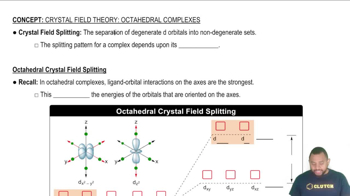Textbook Question
Potassium nitrate has a lattice energy of -163.8 kcal/mol and a heat of hydration of -155.5 kcal/mol. How much potassium nitrate has to dissolve in water to absorb 1.00⨉102 kJ of heat?

 Verified step by step guidance
Verified step by step guidance



Potassium nitrate has a lattice energy of -163.8 kcal/mol and a heat of hydration of -155.5 kcal/mol. How much potassium nitrate has to dissolve in water to absorb 1.00⨉102 kJ of heat?
A solution contains 25 g of NaCl per 100.0 g of water at 25 °C. Is the solution unsaturated, saturated, or supersaturated? (Use Figure 14.11.)
A solution contains 32 g of KNO3 per 100.0 g of water at 25 °C. Is the solution unsaturated, saturated, or supersaturated? (Use Figure 13.11.)
A KCl solution containing 42 g of KCl per 100.0 g of water is cooled from 60 °C to 0 °C. What happens during cooling? (Use Figure 14.11.)